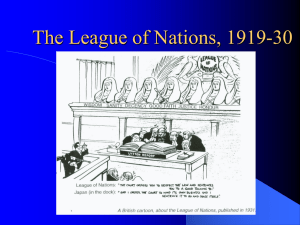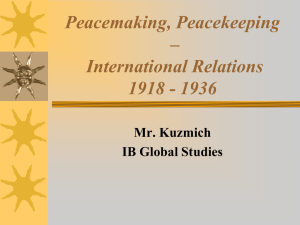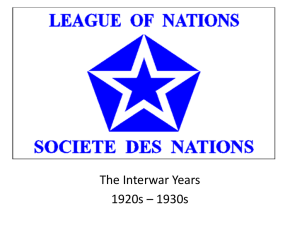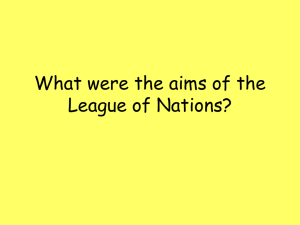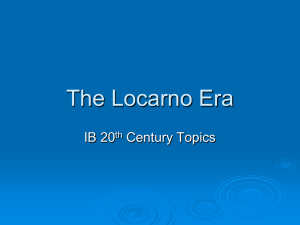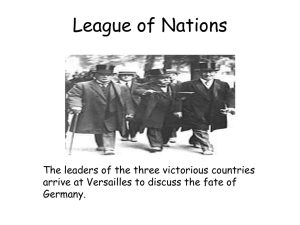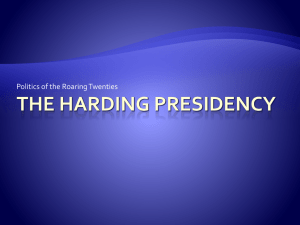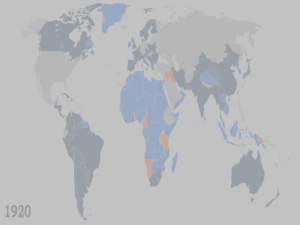Agreements in 20s
advertisement
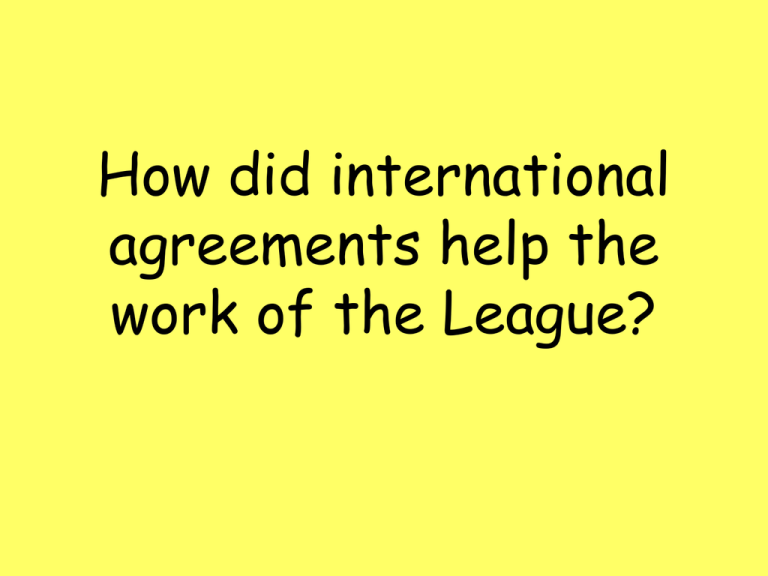
How did international agreements help the work of the League? Fact file • International agreements of the 1920s – • 1921 Washington Conference: USA, Britain, France and Japan agreed to limit the size of their navies. • 1922 Rapallo Treaty: The USSR and Germany re-established diplomatic relations. • 1924 The Dawes Plan: to avert a terrible economic crisis in Germany, the USA lent money to Germany to help it to pay its reparations bill (see page 242). • 1925 Locarno treaties: Germany accepted its western borders as set out in the Treaty of Versailles. • 1928 Kellogg–Briand Pact: 65 nations agreed not to use force to settle disputes. This is also known as the Pact of Paris. • 1929 Young Plan: reduced Germany’s reparations payments. Disarmament • In the 1920s, the League largely failed in bringing about disarmament. At the Washington Conference in 1921 the USA, Japan, Britain and France agreed to limit the size of their navies, but that was as far as disarmament ever got. • The failure of disarmament was particularly damaging to the League’s reputation in Germany. Germany had disarmed. It had been forced to. But no other countries had disarmed to the same extent. They were not prepared to give up their own armies and they were certainly not prepared to be the first to disarm. • Even so, in the late 1920s, the League’s failure over disarmament did not seem too serious because of a series of international agreements that seemed to promise a more peaceful world. The two most important of these agreements were the Locarno treaties and the Kellogg–Briand Pact. • Your homework is to investigate these two treaties in more depth. • Do these 2 treaties show that the League was a success or a failure in the 1920s? Locarno Agreement, 1925 • • The Locarno agreements were greeted with terrific enthusiasm, particularly in France. When news of the agreements was announced, church bells were rung, fireworks were set off and celebrations carried on into the night. The agreements seemed to resolve some of the problems left over from the First World War. France felt that at last it was being given some guarantee of border security. Germany had shown more goodwill towards France than ever before. The agreements paved the way for Germany to join the League of Nations. Germany was granted entry into the League in 1926. Now the Soviet Union was the only major European power not in the League. SOURCE 1 [At Locarno] a great work of peace has been done, above all because of the spirit in which it was done and the spirit which it had created. It would not have been done unless all the governments had felt the need to start a new and better chapter of international relations. Austen Chamberlain, British Foreign Secretary, gives his judgement on the Locarno treaties in 1925. Are these 2 sources making the same point about Locarno? Describe fully the contrasting moods shown in the cartoons. A British cartoon from 1925. Fräulein Gretchen stands for Germany. A British cartoon from 1925. What can you infer from this source about the success of the Locarno Pact? SOURCE 2 The Locarno agreements gave new hope that the League of Nations might assume the role which Wilson had expected of it and that, in spite of the bitterness of the post-war years, a new international order in Europe might be attainable . . . If one tries to look at the European scene between 1925 and 1929 as it appeared at the time, and without the knowledge of what came after, there seemed to be some grounds for hope. Written by historian James Joll in 1983. The Kellogg Briand Pact, 1928 • • Three years after Locarno, the Kellogg–Briand Pact marked the high point of international relations in the 1920s. Its terms are set out in Source 3. Source 3 There was nothing in the Pact about what would happen if a state broke the terms of the agreement. Nor did the agreement help the League of Nations with disarmament. The states all agreed that they had to keep their armies for ‘self-defence’. However, at the time, the Pact was greeted as a turning point in history. If you had asked any observer in 1928 whether the world was a safer place than it had been in the early 1920s, the answer would almost certainly have been yes. 2 1 The parties . . . condemn war as a means of solving international disputes and reject it as an instrument of policy. The settlement or solution of all disputes . . . shall only be sought by peaceful means. Terms of the Kellogg–Briand Pact, signed by 65 nations. How did economic recovery help the League? • One reason for optimism in 1928 was that, after the difficult days of the early 1920s, the economies of the European countries were once again recovering. The Dawes Plan of 1924 had helped to sort out Germany’s economic chaos and had also helped to get the economies of Britain and France moving again (see next slide). • The recovery of trading relationships between these countries helped to reduce tension. That is why one of the aims of the League had been to encourage trading links between the countries. When countries were trading with one another, they were much less likely to go to war with each other. How the Dawes Plan helped economic recovery in Europe. How successful was the League in the 1920s? • The League had 4 objectives, above. • You are going to produce an extended piece of writing to answer the focus question and this is to be submitted next lesson. Task Which of the following statements do you most agree with? 1 The League of Nations was a great force for peace in the 1920s. 2 Events of the 1920s showed just how weak the League really was. 3 The League's successes in the 1920s were small-scale, its failures had a higher profile. • To explain which of these statements you most agree with, you need to answer the question in 4 paragraphs. Paragraph 1 I accept/reject statement 1 because… Paragraph 2 I accept/reject statement 2 because… Paragraph 3 I accept/reject statement 3 because… Paragraph 4 Overall I am most in agreement with statement ? because… Strengths of the League • Many countries supported it in early days they wanted peace • Had some early successes: • Settled some land disputes in 1920’s • helped refugees, dealt with spread of disease, fought for better conditions for people Weaknesses of League • USA didn’t join • No real power - relied on goodwill and persuasion • No permanent army • Disarmament not realistic • Structure a disaster - everyone had to agree before any action taken


